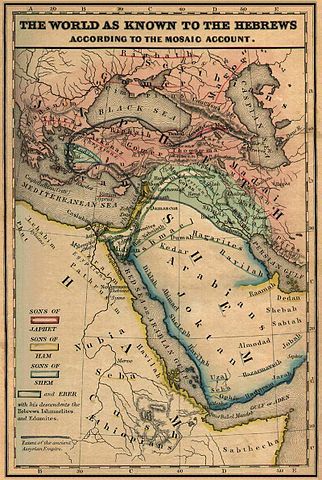
Ashkenaz is shown in Phrygia in this 1854 map of “The World as known to the Hebrews” (Lyman Coleman, Historical Textbook and Atlas of Biblical Geography) | (c) en.wikipedia.org/wiki/Ashkenaz
In this blog post, we embark on a journey to uncover the birth of Ashkenaz, a significant region in medieval Europe with a rich Jewish history. Before diving into the origins of Ashkenaz, let’s first take a glimpse at the Jewish population in the Mediterranean Basin. We’ll explore various regions and their connections to the formation of Ashkenaz, shedding light on the complexities and migrations that shaped the Jewish communities of the time.
Elevate your understanding of our shared history by embarking on a remarkable glatt kosher cruise journey with Kosher River Cruises. Immerse yourself in luxury as you travel on a riverboat, indulging in exquisite kosher dining and daily services. Discover magnificent destinations while enjoying the comfort of onboard luxury. Elevate your glatt kosher holidays to a uniquely Jewish experience, surpassing all expectations.
The Mediterranean Basin: A Patchwork of Cultures
Before Ashkenaz emerged, Western Europe consisted of diverse “countrylets,” while the Byzantine Empire dominated the eastern half of the Roman Empire. This predated the arrival of Muslims in the 7th century. Ashkenaz, located in the north specifically in the Rhineland, became the heartland, with a significant presence in larger France and the Rhone River valley. Although Jews existed in this region during ancient times, their continuity and community status remain uncertain.
Centers of Jewish Population
The eastern part of the Roman Empire, including Persia and the Mesopotamian region, housed major Jewish centers such as Baghdad, Sur, and Bombadita. Additionally, Jewish communities thrived in the Greek-speaking part of the Byzantine Empire and the Italian peninsula since the second century BCE. A smaller Jewish population also resided in the land of Israel.
Scattering Across the European Basin
While limited records exist, scattered Jewish communities emerged along the coast of North Africa, stretching from Egypt to Spain. Despite the lack of substantial documentation, these regions witnessed Jewish migration and settlement. Church records provide glimpses into the Jewish presence in ancient Spain, suggesting their widespread existence throughout the European basin.
Provence: A Region of Importance
One particular area that demands closer examination is Provence, situated in southern France where the Rhone River meets the Mediterranean. During the fifth century, this region served as the border between the Visigothic and Burgundian kingdoms. The Visigoths, originally Aryan Christians, persecuted Jews extensively for over a century. It is plausible that many Jews sought refuge by crossing the Pyrenees into Burgundy and eventually settling in Ashkenaz. Legends also mention a Jewish king in Narbon who played a pivotal role in defending against the Muslims.
The birth of Ashkenaz was not isolated but interconnected with the complex dynamics of Jewish migration, persecution, and the clash of civilizations. While gaps in historical records exist, exploring the origins of Ashkenaz allows us to appreciate the intricate tapestry of Jewish history in medieval Europe. Join us as we continue to delve into the fascinating narrative of Ashkenaz and its lasting impact on Jewish heritage.
